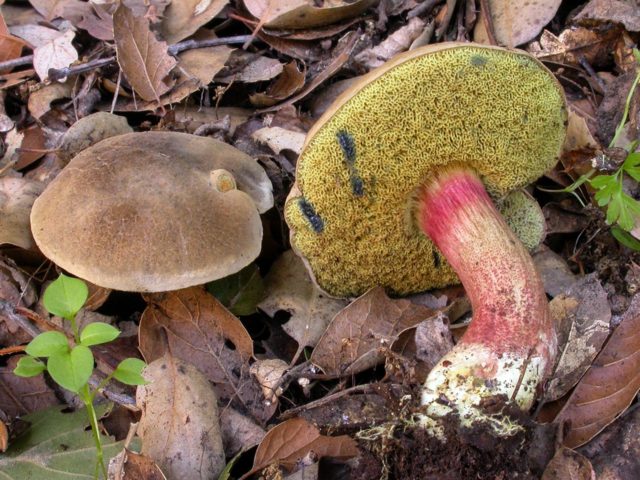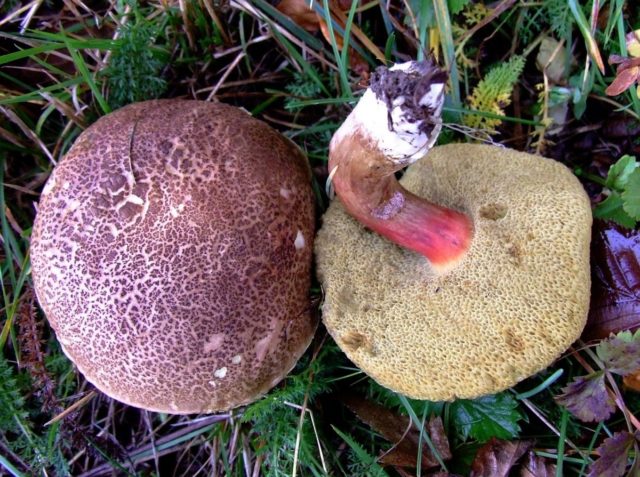Contents
The boletus or flywheel blunt-spored belongs to the Boletaceae family and is considered a close relative of the boletus. Its characteristic difference is that it has spores with a blunt end, but this can only be detected with a microscope. In some sources, this species can be found as a pink-footed flywheel due to the color of the lower part. The official name of the species is Xerocomellus truncatus.
What do blunt-spored flywheels look like
This mushroom is characterized by the classic shape of the fruiting body, so its upper and lower parts are clearly expressed. The cap at the initial stage of growth has a convex shape, and as the flywheel matures, it becomes pillow-shaped. Its diameter does not exceed 15 cm, and the color changes from grayish-brown to chestnut. The surface is dry felt to the touch and remains so even with high humidity. In overripe specimens, the cap may crack, forming a mesh pattern and exposing the flesh, which oxidizes and turns pink. The structure of the upper part is soft, loose, and in adult mushrooms it is cotton-like.
The hymenophore of the flywheel is tubular. Initially, it is a light shade, but as it matures, it acquires a greenish color. The internal tubules can descend along the leg or adhere to it. The spores are spindle-shaped with a cut edge on one side. When ripe, they become brown-olive in color. Their size is 12–15 x 4,5–6 µm.
The leg grows in length up to 10 cm, in the section its diameter is 2,5 cm. The shape is regular cylindrical, slightly narrowed at the base. The surface of the lower part is smooth, the pulp is continuous fibrous. Its main color is yellow, but a pink tint is allowed.

Randomly scattered red spots may appear in the upper part of the stem of the flywheel.
Where do tuposporous flywheels grow
This species is not very common. It can be found in Europe and southern North America. In Our Country, it occurs in the Krasnodar and Stavropol Territories, and single finds have also been recorded in Western Siberia.
The fungus prefers mixed and deciduous plantings. It grows singly and in small groups of 2-4 pieces.
Is it possible to eat blunt-spored flywheels
This species is considered conditionally edible, so you can not use it fresh. The pulp has a sour taste without a characteristic mushroom smell. As the leg matures, it acquires a hard texture, so only hats are suitable for food. Young specimens can be used whole.
False doubles
Flywheel blunt-spored in the structure of the fruiting body and external signs is similar to some mushrooms. Therefore, in order to avoid mistakes during collection, it is necessary to study the characteristic differences of twins.
Similar types:
- Мohovik variegated or fissured. Edible mushroom of the fourth category. The hat is convex, fleshy, its diameter does not exceed 10 cm, even in mature specimens. There is a network of cracks on the surface of the upper part. The color of the cap varies from cherry to brown-gray. The leg is club-shaped. The flesh is a light yellow hue, upon contact with air, it initially turns blue, and then turns red. The official name is Xerocomellus chrysenteron.

The leg of this species is reddish with barely noticeable gray longitudinal streaks.
- gall fungus. This species can only be confused with young flywheels. It belongs to the category of inedible due to the strong bitterness, which only intensifies during heat treatment, as well as poisonous mushrooms. The hat is initially convex, and then flattened. Its surface always remains dry, the color is light brown. The leg is cylindrical, 10 cm long. The lower part has a creamy ocher shade with a mesh pattern. The official name is Tylopilus felleu.

Gall fungus is not wormy
Collection rules
The fruiting period of the flywheel blunt-spored begins in the second half of July and lasts until the end of September. When harvesting, preference should be given to young fruits, as their flesh is denser, and their taste is better.
You need to cut the flywheel with a sharp knife, without damaging the mycelium. This will allow the collection to be carried out annually at the same place.
Use
The blunt-spored flywheel is not particularly popular with mushroom pickers, as its taste is considered mediocre, and the pulp becomes slimy during heat treatment and loses its shape.
Before preparing this type, it is recommended to pre-boil it in salted water for 15-20 minutes, then drain the liquid. Tuposporous flywheel can be pickled, and it is also recommended to cook mushroom caviar on its basis.
Conclusion
The blunt-spored flywheel does not enjoy the special attention of mushroom pickers, since its taste qualities leave much to be desired. This is also due to the fact that the fruiting period coincides with other more valuable species, so many lovers of quiet hunting prefer them.











